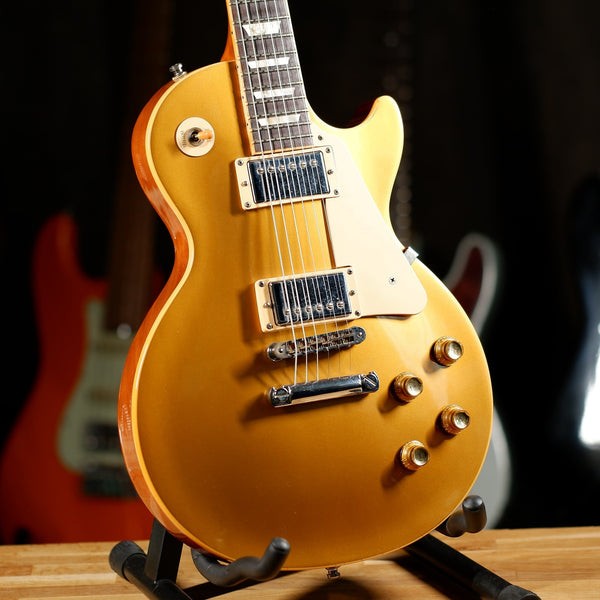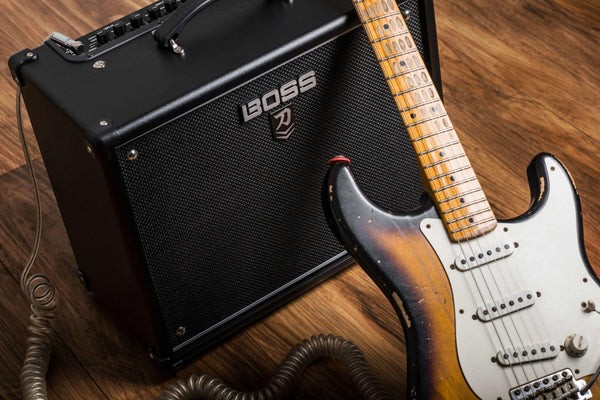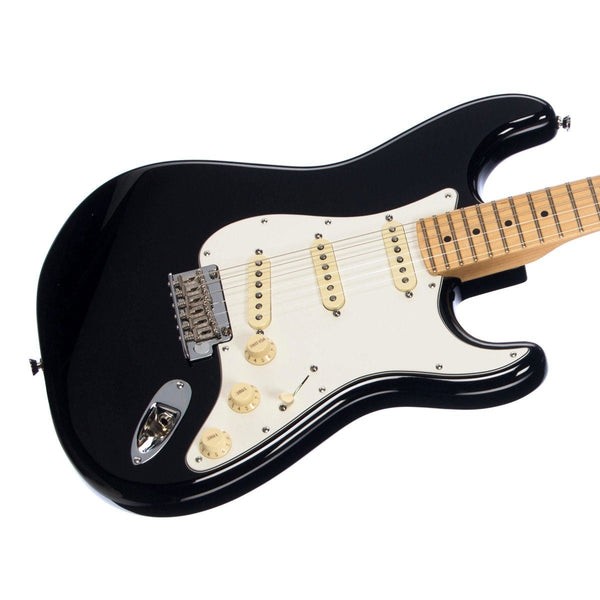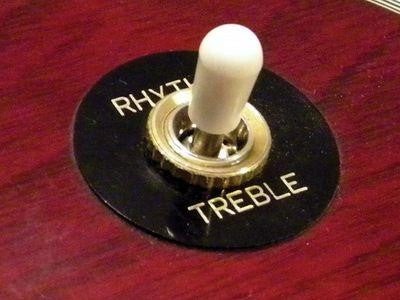Learning How To Learn Playing Electric Guitar opens up a world of musical expression and creativity. At LEARNS.EDU.VN, we provide you with the essential tips, tricks, and resources to master the electric guitar efficiently and effectively. Explore the fundamentals, techniques, and gear knowledge to become a proficient electric guitarist. Dive into guitar lessons, chord charts and scale patterns.
1. Acquire the Essential Electric Guitar Gear
Starting your electric guitar journey with the right equipment is crucial for a smoother learning experience. While a vintage instrument isn’t necessary, having reliable gear significantly aids your progress.
1.1. The Importance of a Quality Guitar
Investing in a decent guitar that stays in tune is essential. It doesn’t need to be the most expensive model, but it should be playable and reliable. Brands like Fender Squier, Epiphone, and Yamaha Pacifica offer good beginner options.
Remember, a very cheap guitar might compromise sound quality and playability, hindering your learning.
1.2. Modeling Amplifiers: A Versatile Choice
A workable amplifier and a dependable guitar cable are must-haves. Modeling amplifiers are a fantastic choice for beginners as they offer emulations of various classic and modern amps.
This allows you to explore different sounds affordably and upgrade later based on your preferences.
1.3. Essential Accessories: Picks, Straps, and More
Don’t forget to get appropriate picks and a comfortable guitar strap. Strap locks are also recommended to prevent the guitar from detaching during energetic performances. Guitar picks vary in size and thickness; experiment with a sample pack to find what suits you best.
2. Understand Your Electric Guitar Equipment Thoroughly
Knowing your gear inside and out is essential. Study the manuals to understand every aspect of your guitar, amplifier, and any additional equipment like pedals. This knowledge provides you with more control over your sound and helps you troubleshoot issues effectively.
2.1. Mastering Guitar Components
Familiarize yourself with the different parts of your electric guitar: body, neck, frets, strings, pickups, tuning pegs, nut, bridge, knobs, and switches. Understanding the function of each component enables you to manipulate your sound effectively.
2.2. Pickup Configuration and Tone Shaping
Different guitars have different pickup configurations. For example, Stratocasters typically have single-coil pickups known for their bright, clear tone, while Les Pauls often feature humbucker pickups that produce a thicker, warmer sound. The toggle switch allows you to select different pickup combinations.
Understanding how each pickup and control knob affects the tone is essential for creating your desired sound.
2.3. Tuning and String Maintenance
Mastering tuning is critical. Utilize phone apps or clip-on tuners for quick and accurate tuning. For performing, consider a pedal tuner in your signal chain. Additionally, learn how to change your guitar strings.
Experiment with different string gauges to find your preference; lighter strings are easier for beginners, while heavier strings provide a thicker sound.
3. Learn to Read Guitar Tabs and Chord Charts
A straightforward way to start learning songs on the electric guitar is by understanding guitar tablature (tabs) and chord charts. No prior knowledge of musical notation is required.
3.1. Understanding Guitar Tablature
Guitar tablature is a simplified method of notating music for the guitar. It consists of six horizontal lines, each representing a string on the guitar. The bottom line corresponds to the low E string (6th string), and the top line represents the high E string (1st string). Numbers on the lines indicate the fret to be played on that particular string.
For instance, if you see a “1” on the top line, play the first fret on the high E string.
3.2. Decoding Chord Charts
Chord charts are another effective way to learn guitar. They often include diagrams that show you how to form chords on the fretboard. Chord diagrams consist of a grid representing the guitar strings and frets. Dots indicate where to place your fingers.
Practice reading chord charts to memorize chord shapes and learn songs quickly.
4. Leverage Online Electric Guitar Resources Wisely
The internet offers a wealth of learning resources for guitarists. However, ensure you use high-quality, accurate sources. At LEARNS.EDU.VN, we curate and provide reliable educational content to support your learning journey.
4.1. Structured Online Courses vs. Random Videos
Opt for structured online courses rather than random YouTube videos. Courses offer a curriculum and progression, helping you build skills systematically. Avoid getting overwhelmed by jumping between unrelated tutorials.
4.2. Benefits of a Disciplined Learning Plan
A disciplined learning plan ensures consistent progress. Follow a structured course and stick with it to avoid confusion and master the fundamentals effectively. LEARNS.EDU.VN provides step-by-step programs designed for guitarists of all levels.
5. Stay Focused With Realistic Goals
Self-motivation and discipline are vital when learning independently. Setting achievable short and long-term goals keeps you focused and motivated.
5.1. Setting Achievable Objectives
Set realistic goals, such as mastering the five forms of the minor pentatonic scale over five months. This breaks down the learning process into manageable steps.
5.2. Creating a Consistent Practice Routine
Develop a consistent practice routine and stick to it. Schedule a specific time each day for practice, and structure your sessions to include warm-ups, scales, chords, and songs. Consistency is key to improvement.
6. Listen Actively: A Musician’s Key Skill
Listening to music is essential for developing your skills as a guitarist. Expose yourself to a variety of genres and guitarists to understand different playing styles and techniques.
6.1. Learning From the Masters
Listen to master guitarists to understand what a guitar should sound like in skilled hands. Pay attention to their techniques, phrasing, and tone.
6.2. Staying Inspired With Fresh Music
Regularly discover new music to keep yourself inspired. Stagnation in listening can hinder progress on the guitar.
6.3. Gaining Insights From Interviews and Live Performances
Watch interviews with your favorite guitarists to understand their approach to music. Attend live performances to experience the energy and atmosphere of live music.
7. Master the Electric Guitar Basics
Regardless of your preferred genre, mastering basic open position chords, barre chords, and major/minor/pentatonic scale patterns is essential.
7.1. Building a Strong Foundation
These elements form the foundation of guitar technique and provide a strong base for further development. Understanding chords and scales allows you to communicate effectively with other musicians.
7.2. Chord Progressions in All Keys
Learn guitar chords in all twelve keys. The CAGED system enables you to move chord shapes up and down the fretboard.
7.3. Scale Patterns
Similarly, learn movable patterns for major, minor, and pentatonic scales. This allows you to play in any key by simply shifting the pattern.
8. Develop Essential Electric Guitar Techniques
Identify and practice the specific techniques used by your favorite guitarists, such as slides, bends, hammer-ons, pull-offs, legato runs, sweep picking, and tapping.
8.1. Exploring Picking Styles
Experiment with different picking styles, including alternate picking, hybrid picking, and fingerpicking. Mastering various techniques allows for greater versatility in your playing.
8.2. Learning Songs, Riffs, and Solos
Learn as many songs, riffs, licks, and solos as you can. This helps you internalize the language of the guitar and develop your own unique style.
9. Master Rhythm With a Metronome
Using a metronome is crucial for developing accurate timing and rhythm. It’s an invaluable practice tool that enhances your musical precision.
9.1. Utilizing Metronome Apps
Download a metronome app on your phone. Start by practicing with the metronome on all four beats, then experiment with different placements, such as on just one beat or on the off-beats.
9.2. Strengthening Your Rhythm Feel
Regular practice with a metronome strengthens your sense of time and rhythm, improving your overall playing ability.
10. Record and Critically Evaluate Yourself
Record your practice sessions using a voice memo app on your phone. Listen back critically to identify areas for improvement and areas where you excel.
10.1. Reflecting on Your Playing
Listening to your recordings allows you to reflect on your progress objectively. Being realistic about your strengths and weaknesses accelerates your development.
11. Embrace Electric Guitar Music Theory
Don’t be intimidated by music theory. It provides a set of concepts, tools, and a language that musicians use to describe musical patterns and tendencies.
11.1. Enhancing Musical Understanding
Music theory enhances your understanding of music and unlocks a wide range of possibilities. It doesn’t limit your creativity; rather, it expands it.
11.2. Understanding Harmony and Structure
Understanding music theory helps you grasp the underlying harmony and structure of music, enabling you to create more informed and compelling compositions.
12. Find a Supportive Electric Guitar Community
Connecting with other guitarists and musicians is crucial for staying inspired and learning new ideas.
12.1. Engaging With Fellow Musicians
Engage with other guitarists and musicians to discuss music, share tips, and learn from their experiences. Whether online or in person, a supportive community accelerates your growth.
12.2. Collaborative Learning
Collaborating with other musicians exposes you to different perspectives and approaches, fostering a richer understanding of music.
13. Consider Enrolling in Electric Guitar Online Courses
While there is plenty of free material available, enrolling in an online course offers structure and guidance that is often lacking in free resources. A well-structured course helps you progress systematically and avoid common pitfalls.
13.1. Structured Learning vs. Unstructured Videos
YouTube can be a valuable resource, but it lacks the structure and guidance of a comprehensive online course. Courses provide a clear path and ensure you cover all the essential topics.
13.2. The Benefits of a Guided Curriculum
A guided curriculum helps you learn efficiently and effectively. You’ll progress faster and enjoy playing your instrument more when you have a clear plan.
14. Overcoming Challenges in Learning Electric Guitar
Many aspiring guitarists face challenges such as finding reliable learning resources, staying motivated, understanding complex concepts, and lacking a structured learning approach.
14.1. Addressing Common Learning Difficulties
It’s crucial to identify these challenges and address them proactively. Seeking guidance from experienced instructors and utilizing reliable resources can help overcome these hurdles.
14.2. Finding the Right Resources and Support
Accessing high-quality learning materials and connecting with a supportive community can make a significant difference in your learning journey.
15. The Role of LEARNS.EDU.VN in Your Electric Guitar Education
LEARNS.EDU.VN is dedicated to providing comprehensive and reliable educational content to support your electric guitar learning journey. We offer detailed tutorials, proven learning methods, and expert guidance.
15.1. Providing Accessible and Effective Learning Materials
Our platform offers a wealth of resources to help you learn guitar effectively. From beginner basics to advanced techniques, we cover a wide range of topics to support your growth.
15.2. Connecting Learners With Expert Educators
LEARNS.EDU.VN connects you with expert educators who provide valuable insights and guidance. Our courses and tutorials are designed to help you master the electric guitar quickly and efficiently.
At LEARNS.EDU.VN, we understand the challenges you face and provide the tools and resources you need to succeed.
16. Embrace the Electric Guitar Learning Journey
Learning to play the electric guitar is a rewarding journey that requires dedication, practice, and the right resources. By following these tips and utilizing the resources available at LEARNS.EDU.VN, you can unlock your musical potential and become a proficient electric guitarist.
16.1. Staying Persistent and Motivated
Persistence and motivation are key to success. Celebrate your progress, stay focused on your goals, and enjoy the process of learning and creating music.
16.2. The Joy of Making Music
Ultimately, learning to play the electric guitar is about the joy of making music. Embrace the journey, explore your creativity, and share your music with the world.
Remember, the journey of learning to play the electric guitar is a marathon, not a sprint. With consistent effort and the right resources, you can achieve your musical goals.
17. Optimizing Your Electric Guitar Learning Experience
To maximize your learning experience, consider the following tips:
- Practice Regularly: Consistent practice, even in short bursts, is more effective than sporadic long sessions.
- Set Realistic Goals: Break down your learning into manageable steps and celebrate your progress along the way.
- Seek Feedback: Share your playing with other musicians and ask for constructive criticism.
- Stay Inspired: Listen to a wide variety of music and explore different genres to keep your creativity flowing.
- Be Patient: Learning takes time, so be patient with yourself and don’t get discouraged by challenges.
By following these tips and utilizing the resources available at LEARNS.EDU.VN, you can create a successful and enjoyable learning experience.
18. Integrating Electric Guitar Learning Into Your Life
Integrating guitar practice into your daily routine can make it easier to stay consistent and motivated.
18.1. Scheduling Practice Time
Set aside specific times for practice each day, just like you would schedule any other important activity.
18.2. Finding Opportunities for Quick Practice Sessions
Even if you don’t have a lot of time, you can still squeeze in quick practice sessions throughout the day. For example, you could practice chords during your lunch break or work on scales while watching TV.
18.3. Making Practice Fun
Make practice enjoyable by learning songs you love, jamming with friends, or exploring new techniques.
19. Leveraging Technology for Electric Guitar Learning
Technology offers a wide range of tools and resources to enhance your learning experience.
19.1. Guitar Learning Apps
There are many guitar learning apps available that offer interactive lessons, chord diagrams, and scale patterns.
19.2. Online Communities and Forums
Online communities and forums provide a platform for connecting with other guitarists, asking questions, and sharing tips.
19.3. Recording and Playback Software
Recording and playback software allows you to record your playing, listen back critically, and identify areas for improvement.
20. The Future of Electric Guitar Education
The future of electric guitar education is likely to be increasingly personalized and technology-driven.
20.1. Personalized Learning Paths
AI-powered learning platforms can create personalized learning paths based on your skill level, goals, and learning style.
20.2. Virtual Reality and Augmented Reality
Virtual reality and augmented reality technologies can create immersive learning experiences, allowing you to practice in virtual environments and interact with virtual instructors.
20.3. AI-Powered Tutors
AI-powered tutors can provide personalized feedback and guidance, helping you improve your technique and overcome challenges.
FAQ: How To Learn Playing Electric Guitar
Q1: Is it possible to learn electric guitar on my own?
Yes, it is entirely possible. With the wealth of online resources and structured courses available, self-teaching is a viable option.
Q2: How long does it take to become proficient at playing electric guitar?
Proficiency varies, but with consistent practice (30-60 minutes daily), you can achieve a decent level of skill within a year.
Q3: What are the essential skills to learn as a beginner?
Essential skills include tuning the guitar, learning basic chords, reading tablature, and practicing scales.
Q4: Do I need to know music theory to play electric guitar?
While not mandatory, understanding music theory enhances your playing and comprehension of music.
Q5: What is the best way to find a good guitar teacher?
Look for experienced teachers with positive reviews. Consider online lessons or local music schools.
Q6: How important is it to practice with a metronome?
Practicing with a metronome is crucial for developing accurate timing and rhythm.
Q7: What are some common mistakes beginners make?
Common mistakes include improper finger placement, neglecting practice, and not seeking feedback.
Q8: How do I stay motivated when learning electric guitar?
Set realistic goals, learn songs you enjoy, and connect with other guitarists for support and inspiration.
Q9: What are the best online resources for learning electric guitar?
LEARNS.EDU.VN offers comprehensive tutorials and courses, along with other reputable online platforms.
Q10: How do I choose the right electric guitar for beginners?
Consider affordable models from reputable brands like Fender Squier, Epiphone, or Yamaha Pacifica. Ensure the guitar is comfortable to play and stays in tune.
Ready to Strum Your Way to Success?
Don’t let the strings hold you back! Whether you’re a complete beginner or looking to sharpen your skills, LEARNS.EDU.VN is your ultimate guide to mastering the electric guitar. We understand the challenges and provide the resources you need to succeed, offering:
- Step-by-step tutorials: Clear, concise instructions to guide you through every technique.
- Proven learning methods: Effective strategies to accelerate your progress.
- Expert guidance: Tips and advice from experienced musicians to help you overcome obstacles.
Visit learns.edu.vn today to unlock your musical potential! Explore our comprehensive courses and discover the joy of playing electric guitar. Contact us at 123 Education Way, Learnville, CA 90210, United States or Whatsapp: +1 555-555-1212. Let’s make some music together!
| Feature | Description |
|---|---|
| Interactive Lessons | Engaging tutorials with step-by-step instructions and video demonstrations. |
| Chord and Scale Diagrams | Clear and easy-to-understand diagrams for learning chords and scales. |
| Personalized Learning Paths | Customized learning plans tailored to your skill level and goals. |
| Community Forums | A platform for connecting with other guitarists, asking questions, and sharing tips. |
| Progress Tracking | Tools for monitoring your progress and identifying areas for improvement. |
| Mobile Accessibility | Access to learning materials on your smartphone or tablet, allowing you to practice anytime, anywhere. |
| Expert Support | Guidance and feedback from experienced guitar instructors. |
| Practice Tools | Metronome, tuner, and recording tools to enhance your practice sessions. |
| Song Library | A vast library of songs to learn, ranging from beginner-friendly tunes to advanced compositions. |
| Gamified Learning | Incorporating game-like elements to make learning more fun and engaging. |
| Multi-Device Sync | Seamlessly sync your progress across multiple devices. |
| Regular Updates | Fresh content and features added regularly to keep your learning experience dynamic. |
| Offline Access | Downloadable content for practicing without an internet connection. |
| Adaptive Difficulty | Lessons adjust to your skill level, ensuring a challenging but manageable learning curve. |
| Integration with Real Gear | Tips on choosing and using real-world guitars, amps, and pedals. |






